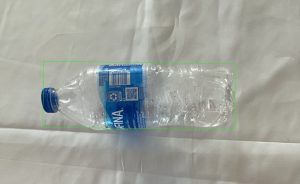This week, I finished setting up the necessary dependencies for the machine learning model (I was able to download correct PyTorch, OpenCV, and NumPy to be able to use the Jetson Orin Nano’s GPU). Moreover, I met up with Alejandro to start the integration process with the machine learning model and the web app. We decided on a scheme to send messages to the web app. Together we were able to get eh bounding boxes to show up on the web app for real-time monitoring.
Currently, I am behind schedule a little as I need to be met up with Alejandro again to setup a communication protocol between the Jetson Orin Nano and the Arduino.
Machine Learning Model Verification:
In order to verify the machine learning model’s performance, I took pictures of real world trash (empty plastic bottles, soda cans, and etc) on the actual conveyor belt. From there I run the model over the images and plotted the bounding boxes to see how tight of a fit it has on the image. From the image below, we can see that the bounding box is able to cover the object and that gives us confidence that we can hit the ±5 center pixel requirement from our design requirements. Moreover from the timing code I wrote, the model runs is able to run 50-70 ms way below our 150 ms design requirement. And finally, on the validation set we were able to get the 0.70 precision that we almost specified in the design requirements.

